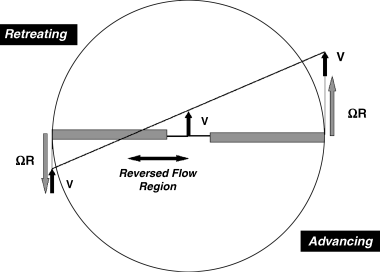Chapter 4
Rotor Mechanisms for Forward Flight1
4.1 The Edgewise Rotor
In level forward flight the rotor is essentially edgewise on to the air stream, a basically unnatural state for propeller functioning. This is shown in Figure 4.1. Practical complications which arise from this have been resolved by the introduction of mechanical devices, the functioning of which in turn adds to the complexity of the aerodynamics.
Figure 4.1 Main rotor alignment in forward flight

Figure 4.2 pictures the rotor disc as seen from above. Blade rotation is in an anticlockwise sense with rotational speed Ω. Forward flight velocity is V and the ratio V/ΩR, R being the blade radius, is known as the advance ratio and given the symbol μ. It has a value normally within the range 0.0 to 0.5. Azimuth angle ψ is measured from the downstream blade position: the range ψ = 0°–180° defines the advancing side and that from 180°–360° (or 0°) the retreating side.
Figure 4.2 Velocity components

A blade is shown in Figure 4.2 at 90° and again at 270°. These are the positions of maximum and minimum relative air velocity normal to the blade, the velocities at the tip being (ΩR+V) and (ΩR−V), respectively. If the blade were to rotate at fixed incidence, then owing to this velocity differential, much more lift would be ...

